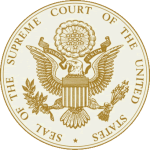- Industry: Government
- Number of terms: 836
- Number of blossaries: 0
- Company Profile:
The highest court in the United States. It's the judicial branch of the United States government. The U.S. Supreme Court has the ultimate appellate jurisdiction over all state and federal courts.
Когда суд следует ли предоставлять certiorari в случае решает и думает, по мнению федерального правительства могут подходить или полезным — несмотря на то, что Соединенные Штаты не являются участником — он может вызвать для представления Генерального солиситора. Генеральный солиситор затем файлы кратко по делу, выражая мнение правительства Соединенных Штатов Америки. Хотя CVSG это технически приглашение, Генеральный солиситор всегда рассматривает его как команда.
Industry:Government
Когда суд «GVRs», он «предоставляет сертиорари,» «освободит» решение ниже и «возвращает» дело в суд низшей инстанции без слушания устных или принятии решения его по существу. GVR порядок не сопровождается письменное мнение, решение по существу дела, но суд обычно предоставляет некоторые направления в суд нижней инстанции, например, инструктируя его пересмотреть свое решение в свете недавнего решения Верховным судом.
Industry:Government
По мнению суда, что слышали дело непосредственно перед проигравшая сторона попросила Верховный суд для рассмотрения дела (почти всегда Федеральный апелляционный суд или государственный суд последней инстанции) известен как мнение ниже.
Industry:Government
In a capital case, the prosecution asks the jury to sentence a defendant on trial for murder to death. By the time a capital case reaches the Supreme Court, the defendant has already been convicted and sentenced, and either the defendant or the government is asking the Court to review a decision by a lower court in the other’s favor.
Industry:Government
The thirteen courts of appeals are federal courts that hear appeals – mostly from federal district (i. E. , trial) courts, but also from federal administrative agencies. Of all the cases the Supreme Court hears, the vast majority come from federal courts of appeals. A court of appeals is often referred to by the name or number of its circuit (i. E. , “Ninth Circuit”).
Industry:Government
When a party in a case is unhappy with the result at the lower court level (that is, in a state court of last resort or in a federal court of appeals), he has the option to file a brief asking the Supreme Court to hear its case. That brief is a petition for certiorari.
Industry:Government
The Supreme Court grants certiorari when it decides, at the request of the party that has filed a petition for certiorari, to review the merits of the case. For roughly every 100 petitions for certiorari received by the court, about one petition is granted. (If the Supreme Court denies certiorari in a case, then the lower court decision stands; the decision to deny certiorari does not make precedent. )
Industry:Government
A habeas petition is a request for a court to review the legality of someone’s detention or imprisonment. All federal courts – not just the Supreme Court – can hear habeas petitions, though federal statutes impose significant constraints.
Industry:Government
Sometimes a judge votes with the majority of the court on the outcome of a case, but wants to write a separate concurring opinion (or “concurrence”). For example, a “concurrence in the judgment” may give different reasons for reaching the same conclusion.
Industry:Government
An unsigned opinion, written for the Court as a whole by an unidentified Justices, is called a per curiam opinion. (In Latin, “per curiam” literally means “by the court. ”) Written dissents from per curiam opinions, however, are signed.
Industry:Government
